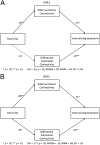Childhood maltreatment is associated with altered fear circuitry and increased internalizing symptoms by late adolescence
- PMID: 24191026
- PMCID: PMC3839755
- DOI: 10.1073/pnas.1310766110
Childhood maltreatment is associated with altered fear circuitry and increased internalizing symptoms by late adolescence
Abstract
Maltreatment during childhood is a major risk factor for anxiety and depression, which are major public health problems. However, the underlying brain mechanism linking maltreatment and internalizing disorders remains poorly understood. Maltreatment may alter the activation of fear circuitry, but little is known about its impact on the connectivity of this circuitry in adolescence and whether such brain changes actually lead to internalizing symptoms. We examined the associations between experiences of maltreatment during childhood, resting-state functional brain connectivity (rs-FC) of the amygdala and hippocampus, and internalizing symptoms in 64 adolescents participating in a longitudinal community study. Childhood experiences of maltreatment were associated with lower hippocampus-subgenual cingulate rs-FC in both adolescent females and males and lower amygdala-subgenual cingulate rs-FC in females only. Furthermore, rs-FC mediated the association of maltreatment during childhood with adolescent internalizing symptoms. Thus, maltreatment in childhood, even at the lower severity levels found in a community sample, may alter the regulatory capacity of the brain's fear circuit, leading to increased internalizing symptoms by late adolescence. These findings highlight the importance of fronto-hippocampal connectivity for both sexes in internalizing symptoms following maltreatment in childhood. Furthermore, the impact of maltreatment during childhood on both fronto-amygdala and -hippocampal connectivity in females may help explain their higher risk for internalizing disorders such as anxiety and depression.
Keywords: child maltreatment; sex differences; ventromedial prefrontal cortex.
Conflict of interest statement
The authors declare no conflict of interest.
Figures




References
Publication types
MeSH terms
Grants and funding
LinkOut - more resources
Full Text Sources
Other Literature Sources
Medical

